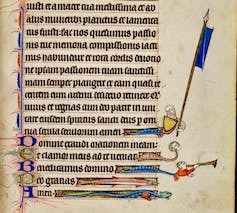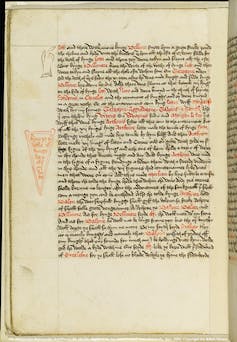![]()
To “doodle” means to draw or scrawl aimlessly, and the history of the word goes back to the early 20th century. Scribbling haphazard words, squiggly lines and mini-drawings, however, is a much older practice and its presence in books tells us a lot about how people engaged with literature in the past.
Although you wouldn’t dare doodle on a medieval manuscript today, squiggly lines (sometimes resembling fish or even elongated people), mini-drawings (a knight fighting a snail, for instance), and random objects appear quite often in medieval books. Usually found in the flyleaves or margins, doodles can often give medievalists (specialists in medieval history and culture) important insights into how people in earlier centuries understood and reacted to the narrative on the page.
It was commonplace to write in margins, underline and annotate, use blank spaces for recipes and handwriting practice, and even color in images. Given the skills and specialization required for writing in the Middle Ages – the training, level of literacy, access to materials, for example – doodles in manuscripts were rarely thoughtless or accidental.
The history of doodling
The origins of doodling in the Middle Ages are hard to pinpoint, but they probably started with pen trials. When we see images of scribes (people who made written copies of documents) writing, they are often depicted with a pen and knife in hand.
The knife was used for a variety of purposes, such as pricking and correcting errors by scraping the parchment. It was also used for gently holding the parchment in place so that the scribe could avoid resting their hand on it, which would risk leaving fingerprints or natural oil from their skin on the surface of the page.
Importantly, the knife was used to adjust the nib of the writing instrument when it became dull after much use. After trimming the nib, the scribe would usually test the pen on a blank piece of parchment or flyleaf to make sure that his letters were legible. Doodles from pen trials were never meant to be seen by the future reader as the flyleaf would later be glued to wooden covers.

Now, though, with modern technology, medievalists can uncover all sorts of messages that lie behind the pages of these ancient books. These types of doodles – an odd name here and there, modest works of art or even a line of music – are important because they give us a rare glimpse into the real day-to-day life of these medieval scribes and what they really thought about the books they were scribing.
We see this in a manuscript cataloged as Cotton Vespasian D. vi, which is currently held in the British Library in London. The scribe has written the Latin words “Probatio Penn[a]e”, which means “pen test”.
Sometimes, though, the scribes were a little bit bolder and wrote more emotively about their work. In Aelfric’s 11th-century Old English De termporibus anni, a concise handbook of natural science, the scribe finishes with:
Sy þeos gesetnys þus her geendod. God helpe minum handum.
Thus, let this composition be ended here. God help my hands.
This scribe was obviously not enjoying their work.
Pen trials such as these show that scribes were not just passive processors of the text, but active participants in making the text.
Marginalia
Doodling in medieval books also brings us into the world of play as readers and scribes then, as now, surrendered themselves to the urge to interrupt empty spaces on the page.
Doodles in the margins – properly known as marginalia – offer the reader some respite from the labours associated with concentrated reading, but also tell us something about how readers reacted to and engaged with the literary world on the page.
For example, although Sir Thomas Malory’s Le Morte Darthur contains relatively few marginalia compared with other medieval manuscripts (80 throughout the 473 surviving folios, by my count), they often mirror the action happening in the narrative in unique ways and demonstrate that the scribes weren’t merely mechanical copiers. Rather, their copying habits are highly sophisticated and provide an example of how, in this case, 15th-century scribes played a role in shaping the reception of literary texts by their contemporary audiences.

Books in the Middle Ages were much more valuable than they are today because of the time, skill and expense it took to make them. Besides being regarded as an object of permanence, to be retained, saved and used as a repository for eternity, medieval books were also public spaces owned by groups of people, institutions or generations of owners (up to today).
Doodles, annotations, marks, commentaries and additions become public declarations. Coupled with the book’s status as an enduring object, it makes sense that readers felt drawn to write their names or doodle in the margins and flyleaves of these books. Through making their mark, they – as ephemeral beings – were inscribing themselves into the book’s eternal living history.![]()
Madeleine S. Killacky, PhD Candidate, Medieval Literature, Bangor University
This article is republished from The Conversation under a Creative Commons license. Read the original article.
Source Link: Why So Many Medieval Manuscripts Feature Doodles – And What They Reveal